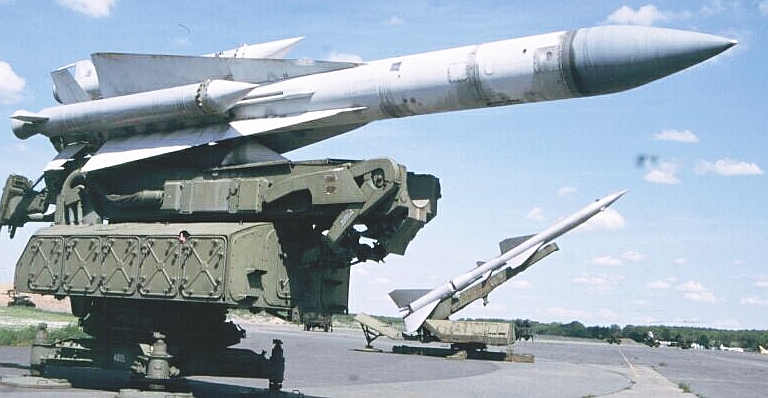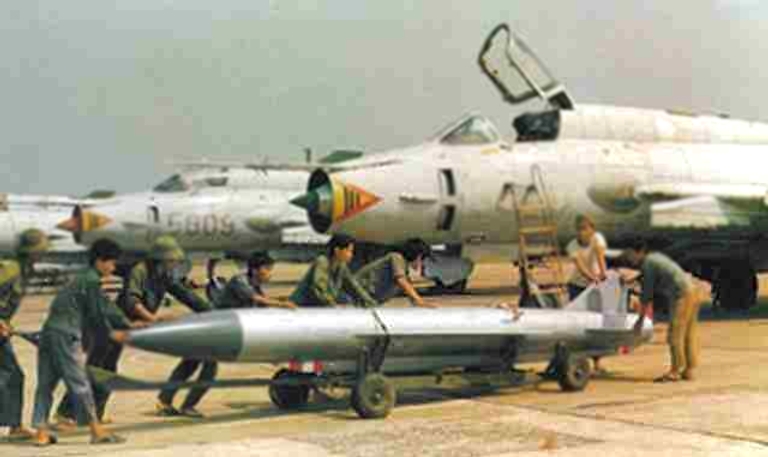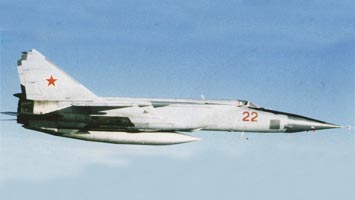First off, if you’re unfamiliar with the acronym in the post
title, SEAD stands for Suppression of Enemy Air Defenses. During wartime,
people generally don’t like having bombs dropped them. (I think they are also
not a fan of having bombs dropped on them during peacetime). So naturally,
military forces develop weapons to keep bombs from getting dropped on them.
Here’s some examples of these weapons;
 |
| http://www.ausairpower.net/PVO-S/5V28-S-200V-Launcher-1S.jpg |
 |
| http://history.redstone.army.mil/miss/chaparral_dodi_002.jpg |
 |
| http://www.military-today.com/artillery/zsu_57_2.jpg |
As a result of this, if your country feels the urge to drop
some bombs on hostile people, you’re going to need to develop a method of
dealing with these weapons. This is what SEAD is (in a nutshell.
On the American side, the first major experience with SEAD
was the Vietnam War. Initially, the main threat facing American strike packages
was small caliber anti-aircraft fire, such as 12.7mm and 14.5mm guns. There was
also a limited number of 37mm, 57mm, and 85mm weapons, mostly of Soviet origin.
However, the arrival of S-75/SA-2 surface-to-air missiles, and their
integration into the North Vietnamese air defense system led to a major upset
operational environment. While the S-75 did not have a particularly high success
rate per individual missile (this DTIC document which I ganked states that 8 American planes were downed by 248 S-75s fired in December 1966,
and these were some of the highest losses due to SAMs in Rolling Thunder), they
did often succeed in forcing aircraft to jettison their ordnance, or descend
into the engagement envelope of light AAA. As an aside, the second point would
be driven home during the War of Attrition and the Yom Kippur War, when
Egyptian 2K12/SA-6 missiles in combination with systems such as the ZSU-23-4
exacted a severe toll on Israeli aircraft.
 |
|
A page from that DTIC report I linked to, showing the
layout of a typical S-75 site.
|
While the initial American response to these developments
was somewhat hampered by the restrictive rules of engagement in the Vietnam
conflict, American forces did manage to develop fairly effective responses.
First, the Americans used electronic countermeasures aircraft, such as the
EB-66, to degrade the effectiveness of the North Vietnamese radar warning
network. While this was not wholly effective (the EB-66s and similar aircraft
were horribly vulnerable to PVAF MiGs, and ECM did virtually nothing against
optically aimed AAA), it did succeed in reducing the effectiveness of North
Vietnamese S-75s. The other portion was the Wild Weasels, aircrews who would
actively hunt down and destroy enemy air defenses assets. Initially, they used
aircraft such as the F-100F, and a wide variety of different weapons, including
unguided rockets and cluster bombs. However, for much of the latter portion of
the Vietnam conflict, the Wild Weasels used F-105F and F-105G aircraft armed
with anti-radiation missiles (in addition to other weaponry).
The Wild Weasels would arrive several minutes before the main
strike package, in concert with electronic support assets. They would hunt down
and destroy hostile air defense assets, which in Vietnam usually took the form
of S-75 sites and protective AAA. Once the air defense assets were neutralized,
the rest of the strike package would proceed to the primary target.
 |
| A mission patch commonly worn by crewmen of Wild Weasel aircraft. |
During the Vietnam period, Wild Weasel missions were
undertaken by dedicated units, the first of which was the 354th
Fighter Wing. Naturally, these first units suffered horrific losses
(anecdotally, after a few months, the 354th had one working aircraft
left, and several of its pilots had resigned). This force structure continued
during the 1970s and 1980s, when the F-4G was used as a dedicated SEAD
airframe.
The most common anti-radiation missile used in Vietnam was
the AGM-45 Shrike. By homing in on the emissions of the S-75s main radar, the
AGM-45 allowed Wild Weasel aircraft to destroy it from a longer distance and
more accurately than could be accomplished with unguided weapons. This
represented a significant improvement in American SEAD capabilities. However,
other weapons still had to be used to destroy the SAM launchers and other
support vehicles, as the Shrike’s relatively small warhead was only sufficient
to destroy the radar itself. Cluster bombs, such as the Mk20 Rockeye were
favored for this purpose.
Later on in the Vietnam conflict, the F-105F/G would be
replaced by modified F-4 variants, due to several attrition of F-105 airframes
during the conflict. Additionally, the AGM-45 was supplanted by the AGM-78
Standard ARM, which had a superior engagement envelope, and would not be
completely fooled if the target radar switched off. However, due to its larger
size and cost, it never fully replaced the Shrike. Later on in the Cold War,
the F-4G, a dedicated Wild Weasel aircraft, became the primary SEAD platform,
and when paired with the AGM-88 HARM, became a highly effective platform. Though
it was never tested in battle against the Soviet Union itself (probably a good
thing), it performed very well against the Iraqi IADS, with only one Wild
Weasel aircraft shot down (the crew survived and ejected over friendly
territory). More recently, since the retirement of the last F-4Gs in the 1990s,
the F-16 has become the primary SEAD platform, with the F-16C Block 50/52 most
commonly used.
Since Vietnam, American SEAD doctrine has, at its core,
remained the same. Highly aggressive usage of anti-radiation missiles to
destroy the emitting radars, coupled with the usage of cluster bombs and similar
weapons to destroy other portions of the air defense system, such as launchers.
With long range target acquisition and SAM radars destroyed, guided and
unguided munitions could be deployed against other short range air defense
assets, such as IR-guided SAMs and AAA guns. Operating against such threats at
close range, American doctrine naturally dictates the use of fighter derived
Wild Weasel platforms. Additionally, for much of the latter part of the Cold
War, the United States used dedicated aircraft variants optimized for SEAD. The
F-105G, as well as the F-4G, were both fitted with specialized avionics (and in
the case of the F-105G, modified from a single-seat base airframe to have two
seats) to optimize them for the SEAD role. More recently, though the F-16C
Block 50/52 was not designed specifically as a SEAD aircraft, its avionics
package is built to allow it to perform that role well. Similarly, American ECM
platforms generally consist of jamming pods mounted to fighters or attack
aircraft, or at the most, attack airframes modified for an ECM role (such as
the EF-111A, or the EA-6B). While were in recent years proposals to build a
standoff jammer on the B-52 platform, they did not come to fruition.
***
The conflict in Vietnam also had a significant effect on
Soviet SEAD doctrine. However, rather than being on the receiving end of dozens
of S-75 launches, they got to observe their effects on the forces of their most
likely opponent. Similarly, the Soviets also learned quite a bit from the
performance of their weapons during the Yom Kippur War. However, while this was
useful for evaluating how their IADS might perform against NATO strikes, it did
not give any concrete information about how to deal with NATO assets. For
instance, how should the VVS make a Hawk site nonfunctional, or prevent a
Roland launcher from forcing a Soviet strike package to abort its mission? When
answering this question, the Soviets’ conclusions were somewhat different from
the Americans’.
 |
|
The MIM-104 Patriot, a likely opponent for a Soviet aircraft
in the late Cold War.
|
During the latter part of the Cold War, the Soviets realized
that NATO forces would most likely have technical superiority over Warsaw Pact
forces in a Western European conflict. As a result, while NATO air defense
systems were not as numerous as their Warsaw Pact counterparts, they would
still represent a potent impediment to Soviet operations.
The Soviet response was highly planned and tailored to the Western
European battlefield. For one, Soviet planners intended to disrupt NATO air
defense networks through use of high altitude nuclear detonations, in concert
with tactical nuclear strikes against certain targets. In particular, I have
seen reference to the usage of OTR-21 ballistic missiles against Hawk and
Patriot sites. The early usage of nuclear weapons by the Soviets, and its
likely escalation into a strategic nuclear exchange, is outside the scope of
this post. However, in addition to any possible uses of nuclear weaponry, the
Soviets also incorporated conventional weaponry into their SEAD doctrine.
The Soviets, having identified what they considered to be
the most important NATO targets in West Germany and nearby regions, intended to
gain local superiority over several airspace corridors needed to attack these
targets. Within these corridors, SEAD aircraft would be responsible for
elimination of NATO air defense assets. Typically, out of any given strike
package for a mission (which might consist of several dozen aircraft), roughly
four to eight aircraft would be tasked with the SEAD mission. These planes
would go in with the main strike package, rather than significantly ahead of it
like the Wild Weasels.
As with the United States, the Soviets also considered
anti-radiation missiles to be of paramount importance in their SEAD arsenal. In
fact, considering that the Soviets placed much lower importance on SEAD aircraft
destroying short ranged assets (it was expected artillery and the like would
deal with them), it could be said that ARMs are of greater proportional
importance to Soviet SEAD doctrine. Compared to American ARMs, Soviet ARMs were
usually larger. Compare, for instance, the size of the Kh-28 to the AGM-45.
 |
| http://www.ausairpower.net/VVS/Kh-28-Kyle-Fitter-1S.jpg |
 |
| http://fas.org/man/dod-101/sys/missile/shrikes.jpg |
The Kh-28 has roughly quadruple the mass of the AGM-45, and
has correspondingly greater range.
Later Soviet missiles continue the trend of large size, with
the Kh-58 massing nearly twice as much as the AGM-88 (the AGM-78 was somewhat
of an anomaly).
The large size of Soviet anti-radiation missiles is a
product of the platforms they were launched from, as well as Soviet doctrine.
Whereas the US used aircraft such as the F-4 and F-105 as the base for their
SEAD platforms, the Soviets instead used aircraft such as the MiG-25BM. A
derivative of the (somewhat) Mach 3 capable MiG-25, the MiG-25BM (known to NATO
as the Foxbat-F) would carry an armament of several Kh-58s in the latter years
of the Cold War.
 |
| http://www.airwar.ru/image/i/fighter/mig25bm-i.jpg |
The Su-24M was also used as a SEAD platform, though that
specific aircraft was not a dedicated SEAD variant like the MiG-25BM. Considering
that both the MiG-25 and Su-24 airframes are both significantly larger than the
F-4 and F-105 (to say nothing of the F-16), the Soviet preference toward larger
aircraft is clear. As a result, instead of launching from close range (usually
well within SAM engagement envelopes) like the Americans, the Soviets would
instead fire their weapons from much farther away, relying on speed and
altitude for safety.
The Soviets’ choices for ECM platforms also differed from
the Americans. While the Americans used jammers which operated relatively close
to the combat area, based on midsize airframes (such as the F-111 and A-6), the
Soviets used larger aircraft as the basis for their jammers, and they operated
at longer range. The most prominent Soviet electronic warfare plane was the
Tu-22P, a modification of an earlier strategic bomber design.
 | |
| http://files.ruslet.webnode.cz/200001638-7f57b7fac6/Tu-22PD_01.jpg |
Electronic warfare variants of the Tu-16, as well as the
An-12 transport aircraft, also existed, and would have been used against NATO
assets in the event of war. (I have also seen a few references to an An-12
modified to carry the Kh-28, although I believe it was just for test purposes).
The relative effectiveness of American and Soviet SEAD
doctrines in a high intensity conflict has not yet been fully tested. However,
both nations have done so in lower intensity conflicts within the past few
decades. The first major test of US SEAD tactics post-Vietnam was the Persian
Gulf War. In this conflict, American aircraft performed very well against the
Iraqi IADS. However, it was not perfect; multiple Coalition aircraft were lost
to Iraqi defenses, and Baghdad itself remained off limits to all aircraft
besides the F-117. The US also did not perform perfectly in Yugoslavia; the
loss of an F-117 to a (relatively outdated) S-125 is well known, and
Yugoslav/Serbian SAM operators demonstrated remarkable abilities to outsmart
NATO planners. The performance during Operation Iraqi Freedom was significantly
better, with only one plane being lost to an Iraqi Roland SAM (US Patriot
missiles actually destroyed a greater number of Coalition aircraft). Of course,
the Iraqi air defense network had been significantly reduced from 1991 levels.
While the 1980s Afghanistan conflict is (not entirely inaccurately)
considered to be a Soviet analogue of Vietnam, Soviet SEAD doctrine was not
heavily tested. The Soviets gained air dominance almost immediately, and the
Afghanis possessed relatively little in the way of integrated air defense systems
(Stingers and other MANPADSs were another matter entirely). Likewise, the
conflict in Chechnya, while very protracted and brutal, offered little in the
way of significant tests for Soviet/Russian SEAD doctrine (again, MANPADSs were
a significant concern, as evidenced by the shootdown of an Mi-26 which caused
over 100 casualties). Probably the most serious test of Russian SEAD tactics
came in the 2008 Ossetian War. In this case, while Georgian air defense assets
were reduced in effectiveness, they still performed will, with several Russian
aircraft being destroyed, including at least one Tu-22M3.
Whether this is due to intrinsic flaws in Russian SEAD
doctrine, exceptional Georgian skill, or the general decrease in competency of
Russian forces following the fall of the Soviet Union is uncertain.


No comments:
Post a Comment